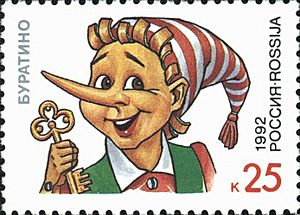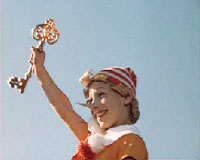Buratino facts for kids

Buratino (Russian: Буратино) is the main character in a famous Russian children's book. The book is called The Golden Key, or the Adventures of Buratino. It was written in 1936 by Aleksey Nikolayevich Tolstoy. This story is based on the Italian novel The Adventures of Pinocchio by Carlo Collodi.
The name Buratino comes from the Italian word burattino. This word means a wooden puppet or doll. The book became super popular with children in the Soviet Union when it came out. It is still one of the most loved characters in Russian children's literature today. The story has been made into several movies. These include an animated film in 1959 and a live-action film in 1975.
Contents
How the Story Began
Aleksey Tolstoy said he read Pinocchio when he was a child. Years later, he wanted to tell bedtime stories to his own children. He started to remember and change the Pinocchio story. His new version became so special that his children loved it. So, he decided to write it down and publish it. This is how The Golden Key was created.
Buratino's Adventures
Just like Pinocchio, Buratino is a wooden puppet with a long nose. In the story, an old man named Papa Carlo carves him from a log. Suddenly, Buratino comes to life! His nose is long because Papa Carlo was a bit messy when carving. Papa Carlo tries to make it shorter, but Buratino won't let him.
Papa Carlo is poor, but he sells his only good jacket. He uses the money to buy school books for Buratino. He sends Buratino to school. But Buratino gets sidetracked by an advertisement for a puppet show. He sells his new textbooks to buy a ticket to the show.
At the puppet show, Buratino makes friends with other puppets. But the mean puppet master Karabas Barabas gets angry. Buratino had messed up his show. Karabas Barabas wants to destroy him.
Karabas Barabas lets Buratino go when he learns something important. He finds out that Papa Carlo's house has a secret door. Karabas has been looking for this door for a long time. A Golden Key that Karabas once had, but lost, opens this secret door. Karabas lets Buratino go. He even gives him five gold coins. He only asks Buratino to watch his father's home. He wants to make sure they don't move.
The story then follows Buratino and his friends. They search for the Golden Key. They also fight against the evil Karabas. Karabas has a loyal friend named Duremar. There are also two tricky crooks: Alice the Fox and Basilio the Cat. These two are after Buratino's gold coins. Many of Buratino's later adventures are similar to Pinocchio. But they are changed to fit Tolstoy's unique story.
How Buratino's Story is Different from Pinocchio
Tolstoy's story has some fun differences from the original Pinocchio:
- In Tolstoy's story, the Fairy with Turquoise Hair is a puppet named Malvina. She has blue hair and a poodle servant named Artemon. She helps Buratino when the Fox and Cat try to trick him. She had escaped from Karabas's theater.
- A new character, Pierrot, is added. He is a sad poet who loves Malvina.
- Tolstoy removed many parts that might seem too scary or preachy today. For example, Pinocchio burning his feet or the Land of Toys.
- Unlike Pinocchio, Buratino does not become a real human boy. He stays a wooden puppet. He is rewarded for being himself, even if he doesn't always follow the rules.
- Buratino's nose does not grow when he tells a lie.
Main Characters
- Buratino is a wooden puppet with a long nose. He is the main hero.
- Papa Carlo (Russian: Папа Карло) is a poor barrel organ player. He carves Buratino and becomes his father.
- Giuseppe (Джузеппе) is a woodworker and Papa Carlo's friend. He found the talking log and gave it to Papa Carlo.
- Karabas Barabas (Карабас-Барабас) is the mean puppet master. He owns a puppet theater with many puppets.
- Malvina (Мальвина) is a beautiful female puppet with blue hair. She is kind and smart.
- Artemon (Артемон) is Malvina's loyal poodle dog.
- Pierrot (Пьеро) is a sad puppet and a poet. He is deeply in love with Malvina.
- Harlequin (Арлекин) is Pierrot's stage partner. He often teases Pierrot.
- Alice the Fox (Лиса Алиса) and Basilio the Cat (Кот Базилио) are two tricky swindlers. They try to cheat Buratino.
- Tortila the Turtle (Черепаха Тортила) is a wise old turtle. She gives the Golden Key to Buratino.
- Duremar (Дуремар) is a partner of Karabas Barabas. He catches leeches and bothers Tortila's pond.
Movies and Games
The story of Buratino has been made into several popular adaptations:
- The Golden Key, a 1939 movie that mixed live actors and stop-motion animation.
- The Adventures of Buratino, a cartoon from 1959.
- The Adventures of Buratino, a TV film from 1975.
- Buratino, Son of Pinocchio, a movie released in 2009.
- A computer game called The Adventures of Buratino came out in 1993. It was one of the first graphic adventure games released in Russia after the Soviet Union.


